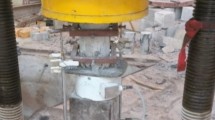Abstract
In the present experimental study, glass fibers were used in varying dosages of 0.5, 1.0, and 1.5% of cement content (by weight) as partial cement replacement to cement in concrete mix. The effect of different dosage of glass fibers on the bond strength between steel and concrete in reinforced concrete was investigated. As a part of durability study, the combined effect of marine environment and varying levels of pH on the ultimate bond strength retention and compressive strength retention of glass fiber reinforced concrete was also studied. Durability studies were carried out by exposing the 28-day cured cubical specimens into marine environment having different pH levels (1, 4, 7, 10 and 13). The salt solution was simulated in the laboratory by adding 3.5% NaCl to the tap water. Calculated amount of sulphuric acid was added to salt solution to maintain pH of 1 and 4 in marine environment. Similarly, calculated amount of sodium hydroxide was added to salt solution to maintain pH of 10 and 13 in marine environment. The specimens were exposed to aggressive environment for a period of 60 and 90 days. As the fiber dosage increased the workability reduced, and 1.5% fiber dosage had the least slump value. The addition of glass fibers had very minimal influence on compressive strength of glass fiber reinforced concrete. The ultimate bond strength of concrete increased due to the addition of glass fibers. The increase in ultimate bond strength was confirmed through SEM images which shows proper bonding between cement paste and glass fibers. As for as the exposure studies are concerned, 1.0% fiber dosage of glass fiber reinforced concrete had shown better compressive strength and ultimate bond strength retention compared to 0.5 and 1.5% fiber dosage. The pH of the marine environment has a decisive influence on the compressive strength retention and bond strength retention. Exposure to marine environment with pH 1 suffered severe loss in compressive strength and ultimate bond strength with very low strength retention values. However, exposure to marine environment with pH 10 and 13 had minimal strength losses with higher values of compressive strength and ultimate bond strength retention. Increase in exposure period to aggressive media leads to decrease in compressive strength and ultimate bond strength, but the strength retention values for glass fiber reinforced concrete were comparatively better compared to control concrete.
Access this chapter
Tax calculation will be finalised at checkout
Purchases are for personal use only
Similar content being viewed by others
References
Neville, A. (1995). Chloride attack of reinforced concrete: an overview. Materials and Structures, 28, 63.
Zhandarov, S., & Mäder, E. (2005). Characterization of fiber/matrix interface strength: applicability of different tests, approaches and parameters. Compos. Sci. Technol., 65, 149–160.
Ezeldin, A. S., & Balaguru, P. N. (1992). Normal-and high-strength fiber-reinforced concrete under compression. Journal of Materials in Civil Engineering, 4, 415–429.
Zhu, W., & Bartos, P. J. M. (1997). Assessment of interfacial microstructure and bond properties in aged GRC using a novel microindentation method. Cement and Concrete Research, 27, 1701–1711.
Chandramouli, K., Srinivasa Rao, P., Seshadri Sekhar, T., Pannirselvam, N., & Sravana, P. (2010). Rapid chloride permeability test for durability studies on glass fiber reinforced concrete. ARPN: Journal of Engineering and Applied Sciences, 5, 67–71.
Nobili, A. (2016). Durability assessment of impregnated glass fabric reinforced cementitious matrix (GFRCM) composites in the alkaline and saline environments. Construction and Building Materials, 105, 465–471.
Okochi, H., Kameda, H., Hasegawa, S., Saito, N., Kubota, K., & Igawa, M. (2000). Deterioration of concrete structures by acid deposition—An assessment of the role of rainwater on deterioration by laboratory and field exposure experiments using mortar specimens. Atmospheric Environment, 34, 2937–2945.
Author information
Authors and Affiliations
Corresponding author
Editor information
Editors and Affiliations
Rights and permissions
Copyright information
© 2019 Springer Nature Singapore Pte Ltd.
About this paper
Cite this paper
George, R.M., Das, B.B., Goudar, S.K. (2019). Durability Studies on Glass Fiber Reinforced Concrete. In: Das, B., Neithalath, N. (eds) Sustainable Construction and Building Materials. Lecture Notes in Civil Engineering , vol 25. Springer, Singapore. https://doi.org/10.1007/978-981-13-3317-0_67
Download citation
DOI: https://doi.org/10.1007/978-981-13-3317-0_67
Published:
Publisher Name: Springer, Singapore
Print ISBN: 978-981-13-3316-3
Online ISBN: 978-981-13-3317-0
eBook Packages: EngineeringEngineering (R0)




